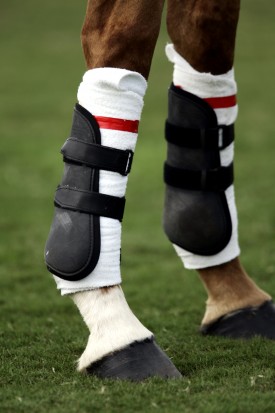

Protecting a horse or ponies legs are essential for keeping them fit and happy. Boots can prevent injuries in competition, as well as help stop recurring injuries in horses with less-than-perfect conformation. Look in any Tack Shop however and you will be faced with a vast array of boots and bandages. Knowing which boot is which, and when to use them is important before you consider buying. Boots should be used to protect the horse, not just to make them look good! This is a guide to schooling, competition, turnout and travelling uses of boots, so you know what to buy and when to use it on your horse.
Brushing boots protect the inside of each leg, fore and hind, from the opposite hoof knocking into the lower leg and fetlock. As a result they run from just under the knee, down the inside of the leg and cover the fetlock. These are a multi-purpose boot and can be used for schooling (especially lunging when a horse is working on a curve), hacking and competition (where the rules allow). If your horse is fresh, they can also be turned out in them to protect the legs from any accidental injuries as they bolt around the field.
These boots are used on the front legs only, protecting the tendon on the back of the legs. They are primarily used in Show Jumping, where the hind legs can catch the tendon on landing. The front of the boot is open so a horse will pick up his forelegs and not knock poles down with the front of their cannon bone. The boot runs from under the knee and also protects the fetlock.
Over Reach Boots are useful in competition, and help prevent injuries in young horses or those with short backs. The boot protects the heel from being clipped by the back hooves, absorbing the impact and stopping cuts and grazes. They are often combined with Tendon Boots in jumping competitions, or Brushing Boots when lunging or schooling.
Fetlock boots are used primarily with tendon boots in Show Jumping classes. They cover the inside of the fetlock on the hind legs, absorbing any impact if they knock their fetlocks in the air or as they land. They are much smaller than tendon boots, so you must check they are secure before any class.
These are hard, protective boots primarily used for travelling. Knee boots protect the front of the knee, absorbing any knocks inside the trailer or horsebox. Hock boots cover the back of the hock, usually with thick felt or wool covering the sides of the joint. If your horse or pony likes to roll or lie down in the stable, they can help stop cuts and grazes. When hacking over rough terrain or gravel roads, knee boots are particularly useful to avoid injuries especially with clumsy or young horses.
As equine science has progressed, travelling boots have become easier to use. Traditionally you would travel your horse or pony in a combination of bandages, knee and hock boots. Now you can buy boots which cover the horse’s legs from knee to coronet, or hock to coronet on the back legs. They are usually quilted with Velcro straps, so they can be taken on and off quickly. Due to their size and padding, it is advised not to leave these boots on outside of the horsebox or trailer. They aren’t designed for lots of movement.
Bandages can be used for almost any form of protection – in schooling, turn out, competition or hacking. With the amount of easy to use protective boots, they are most commonly used to support high impact flat work (such as dressage) as they offer more support to tendons and fetlock joints. Horses recovering from injuries can benefit from them, providing protection from contamination as well as strengthening the leg. Should you not have time before a show to wash your horse, bandages can also be used to keep the legs clean overnight.
Always be careful when using bandages that they are not too tight – cutting off circulation and legs over heating is a common problem with over enthusiastic binding. If your bandage is protecting an injury, make sure you check and change them often. Always take the advice of your vet.
Boots come in a variety of sizes – Small, Medium and Large, or Pony, Horse and Cob. You should base your purchase on the height, body weight and circumference of you horse or pony’s leg. Make sure you measure your equine’s leg before you go to your Tack Shop and ask advice if this is your first purchase.
It is important the boot fits snugly, so it absorbs the impact yet doesn’t rub the leg. Boots are made from leather, rubber or synthetic materials, with either buckle or Velcro straps. Make sure you read the maker’s instructions to ensure the boot is not too tight or lose, or you will cause injuries unwittingly. When putting them on run the boot down the leg, so the hair lies flat. Straps should always be done up on the outside of the leg, being pulled from the front of the horse, to the rear.
Boots should be removed as soon as possible after competition or schooling. The leg will need to cool down, and hair dry from any sweat produced. If legs are warm, wash them down with a sponge and/or hose.
Clean your boots after use. Any collection of dirt or grit will rub your horse, and the lining can also develop bacteria that could cause infection. Leather boots can be cleaned using the same products as your saddle and bridle. To remove grease and grime, use a nail brush with washing up liquid. Some synthetic boots are machine washable – check your boot instructions before you throw them into the washing machine!
Copyright © 2005-2016 Pet Information All Rights Reserved
Contact us: www162date@outlook.com